When it comes to jumbo-sized sushi, many Taiwanese foodies immediately think of San Wei Shi Tang (三味食堂). This neighborhood eatery gained national fame when a blogger posted a photo on the Internet several years ago showing that its nigiri roll was bigger than a mobile phone. It is now one of the busiest restaurants in town, and reservations are not available.
San Wei (三味) refers to the restaurant’s three characteristics: good food, good memories and good flavors (美味、回味、好滋味). Shi Tang (食堂) simply means “dining hall” in Chinese.
Established 18 years ago at the edge of Ximending (西門町), San Wei is about a 15-minute walk from Ximen MRT Station (西門站). Arriving for lunch at 1pm on a weekday, the restaurant was still full while dozens of guests were waiting outside. After obtaining a number from the waiter, my friend and I waited for over 30 minutes until our number finally flashed on a display by the door. We were quickly seated at a small square table with stools on the first floor of the two-story restaurant. It was rather clean but very crowded inside.
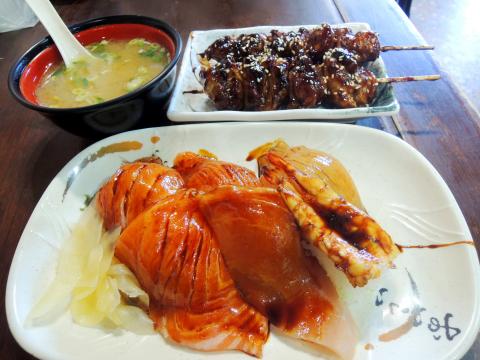
Photo: Eddy Chang, Taipei Times
At San Wei, you need to write down your orders by yourself. But don’t worry. Waiters can explain the menu in English and Japanese if you can’t read Chinese. The extensive menu offers 60 to 70 classic dishes, as well as free miso soup and refills. We ordered the popular sashimi combo (生魚片, NT$300) and the nigiri combo half-set (握壽司[半份], NT$160). The sashimi combo included tuna, salmon, cuttlefish and crab sticks. The raw fish was thickly sliced and we could clearly taste the sweetness of the fish.
The restaurant’s signature dish, the nigiri combo half-set (raw fish on vinegar rice) included three nigiri rolls. And if you feel hungry, you can always try the whole set (NT$250) with six rolls: tuna, salmon, spearfish, amberjack, cuttlefish and shrimp. Although it was not our first visit, we were overwhelmed by the giant size of the rolls, which were several times larger than regular rolls. I really enjoyed the large pieces of fish over small dabs of rice, whose vinegar flavor was not too strong. The chef already applied some wasabi to glue the fish to the rice and brushed some soybean sauce on the fish to make it shiny and flavorsome, so I suggest that diners not add too much wasabi or soybean sauce when eating the rolls.
We also ordered an asparagus hand roll (蘆筍手卷, NT$70) and a sea urchin hand roll (海膽手卷, NT$140). The hand rolls were so big that they were served in beer glasses. The sea urchin roll was particularly fine, and the chef put a generous amount on my roll.
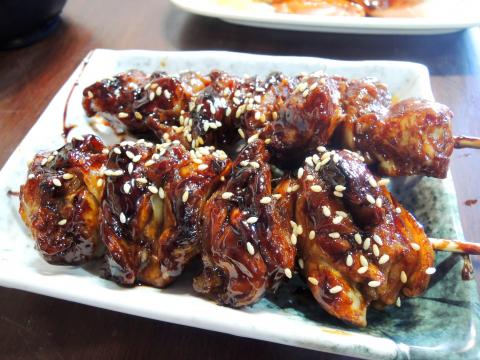
Photo: Eddy Chang, Taipei Times
For grilled items, the grilled chicken skewer with barbecue sauce (雞肉串燒, NT$60) was my favorite. There were four big chunks of chicken on each stick, and the meat was slightly burned with white sesame sprinkled on the surface to enrich its flavor.
For fried items, we ordered the deep-fried vegetable tempura (野菜天, NT$140) featuring taro and yam slices, some burdocks and string beans. But I was not very impressed with the battered and deep-fried vegetables, and the sauce was light and flavorless.
At previous visits, I had the vegetable salad (野菜沙拉, NT$130) and would highly recommend it. The mix of lettuce, cucumber, corn, black soybeans, fish egg and mashed potato is a good combination. Both the fried chicken (雞肉唐揚, NT$150) and fish and shrimp tempura (炸魚蝦天, NT$220) also deserve a try.
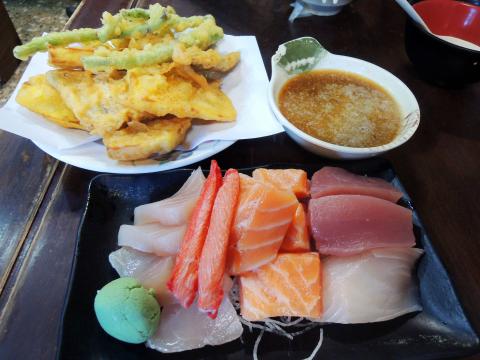
Photo: Eddy Chang, Taipei Times
The lunch for two cost me NT$930, and there is no service charge. We could not finish the vegetable tempura and had to take it home. Overall, if you like large portions of Japanese food with a fair quality and price (and do not care about the atmosphere), San Wei may be a good option.
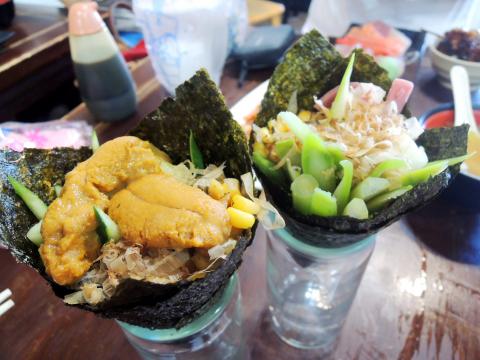
Photo: Eddy Chang, Taipei Times

From the last quarter of 2001, research shows that real housing prices nearly tripled (before a 2012 law to enforce housing price registration, researchers tracked a few large real estate firms to estimate housing price behavior). Incomes have not kept pace, though this has not yet led to defaults. Instead, an increasing chunk of household income goes to mortgage payments. This suggests that even if incomes grow, the mortgage squeeze will still make voters feel like their paychecks won’t stretch to cover expenses. The housing price rises in the last two decades are now driving higher rents. The rental market

July 21 to July 27 If the “Taiwan Independence Association” (TIA) incident had happened four years earlier, it probably wouldn’t have caused much of an uproar. But the arrest of four young suspected independence activists in the early hours of May 9, 1991, sparked outrage, with many denouncing it as a return to the White Terror — a time when anyone could be detained for suspected seditious activity. Not only had martial law been lifted in 1987, just days earlier on May 1, the government had abolished the Temporary Provisions Effective During the Period of National Mobilization for Suppression of the Communist
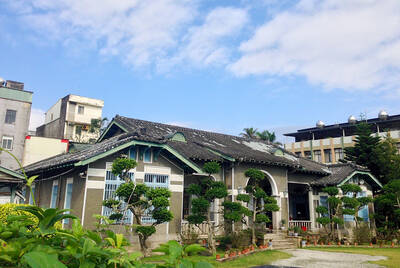
When life gives you trees, make paper. That was one of the first thoughts to cross my mind as I explored what’s now called Chung Hsing Cultural and Creative Park (中興文化創意園區, CHCCP) in Yilan County’s Wujie Township (五結). Northeast Taiwan boasts an abundance of forest resources. Yilan County is home to both Taipingshan National Forest Recreation Area (太平山國家森林遊樂區) — by far the largest reserve of its kind in the country — and Makauy Ecological Park (馬告生態園區, see “Towering trees and a tranquil lake” in the May 13, 2022 edition of this newspaper). So it was inevitable that industrial-scale paper making would

Hualien lawmaker Fu Kun-chi (傅?萁) is the prime target of the recall campaigns. They want to bring him and everything he represents crashing down. This is an existential test for Fu and a critical symbolic test for the campaigners. It is also a crucial test for both the Chinese Nationalist Party (KMT) and a personal one for party Chairman Eric Chu (朱立倫). Why is Fu such a lightning rod? LOCAL LORD At the dawn of the 2020s, Fu, running as an independent candidate, beat incumbent Democratic Progressive Party (DPP) lawmaker Hsiao Bi-khim (蕭美琴) and a KMT candidate to return to the legislature representing